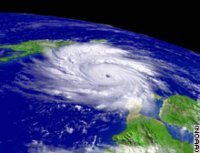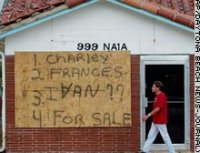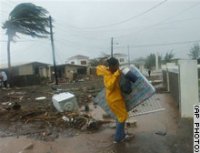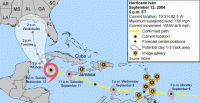Littledragon
Above The Law
This news should deserve a thread on its own.
Post any information or updates on yet another Hurricane, Ivan.
ST. GEORGE'S, Grenada (AP) -- Hurricane Ivan intensified Thursday, heading straight for Jamaica and possibly Florida with 160 mph winds after it killed at least 16 people while pummeling Grenada, Barbados and other islands.
The most powerful hurricane to hit the Caribbean in 10 years damaged 90 percent of the homes in Grenada, killing 13 people there, and destroyed a 17th century stone prison that left criminals on the loose as looting erupted, officials said Wednesday.
Ivan is expected to reach Jamaica by Friday and Cuba by the weekend, the U.S. National Hurricane Center in Miami, Florida, said.
Tourists and residents also were told to evacuate the Florida Keys because Ivan could hit the island chain by Sunday. It was the third evacuation ordered there in a month, following Hurricane Charley and hard on the heels of Hurricane Frances. (Full story)
Hurricane Ivan strengthened early Thursday to become a Category 5 on a scale of 5. It packed sustained winds of 160 mph with higher gusts as it passed north of the Dutch Caribbean islands of Aruba, Bonaire and Curacao.
Jamaican leader P.J. Patterson urged his people to pray.
"We have to prepare for the worst case scenario. Let us pray for God's care," Patterson said Wednesday night. "This is a time that we must demonstrate that we are indeed our brothers' and sisters' keeper."
Amy White, a 29-year-old American living in Jamaica, was planning to fly out of the island Thursday morning for her parents' house in Monroe, New Jersey.
"They got worried so they said they wanted me to come home," said White, a marketing manager for a clothing apparel company in Kingston. "I've never been in a hurricane like this before. I feel like it's fate so I'm gonna go."
British Navy assisting
The United States, meanwhile, declared Grenada a disaster area, allowing the immediate release of $50,000 for emergency relief.
"This is just a jump start," said spokesman Jose Fuentes of the U.S. Agency for International Development in Washington D.C., which has four members on the ground in Grenada. "As soon as the initial assessment is done we'll be sending more aid."
Fuentes said at least 13 storm-related deaths had been reported in Grenada. Police officials earlier had reported 12 deaths.
Details on the extent of the death and destruction in Grenada did not emerge until Wednesday because the storm cut all communications with the country of 100,000 people, and halted radio transmissions on the island.
"We are terribly devastated ... It's beyond imagination," Grenada's Prime Minister Keith Mitchell told his people and the world on Wednesday -- from aboard a British Royal Navy vessel that rushed to the rescue.
British Royal Navy crews from two ships said Thursday they have cleared the damaged and flooded airport runway outside Grenada's capital, St. George's, and that emergency relief flights were starting to arrive in the former colony.
"The air traffic control is still inoperative, so it's not like flight after flight is coming in," Navy spokesman Cmdr. Richard Buckland said from London.
Mitchell confirmed that the island's 17th century stone prison was "completely devastated" allowing convicts to escape, including politicians jailed for 20 years for killings in a 1983 left-wing palace coup that led the United States to invade.
Grenada is known as a major world producer of nutmeg and for the U.S. invasion that followed the coup, when American officials had determined Grenada's airport was going to become a joint Cuban-Soviet base. Cuba said it was helping build the airport for civilian use. Nineteen Americans died in the fighting and a disputed number of others that the United States put at 45 Grenadians and 24 Cubans.
Mitchell, whose own home was flattened, said he feared the death toll would rise and much of the country's agriculture had been destroyed, including the primary nutmeg crop.
U.N. spokesman Fred Eckhard said virtually every major building in St. George's has suffered structural damage and the United Nations was sending a disaster team. Grenada's once-quaint capital boasted English Georgian and French provincial buildings.
Looters out, police hindered
The Caribbean disaster response agency, based in Barbados, said its team arrived Wednesday afternoon along with U.S. aid and Pan American Health Organization officials.
"It looks like a landslide happened," said Nicole Organ, a 21-year-old veterinary student from Toronto at St. George's University, which overlooks the Grenadian capital. "There are all these colors coming down the mountainside -- sheets of metal, pieces of shacks, roofs came off in layers."
Students there, mostly Americans, were arming themselves with knives, sticks and pepper spray against looters, said Sonya Lazarevic, 36, from New York City. "We don't feel safe," she said on a bad telephone line.
When Organ wandered downtown after the hurricane passed, she said she saw bands of men carrying machetes looting a hardware store. She said she saw a bank with glass facade intact on her way down that was totally smashed when she returned.
Bedaau said every Grenadian police station was damaged, hindering efforts to control looting. He said police were trying to set up a temporary post at St. George's fish market, and that Trinidad and other Caribbean countries were sending troops.
Elsewhere, Ivan pulverized concrete homes into piles of rubble and tore away hundreds of landmark red zinc roofs.
Its howling winds and drenching rains also flooded parts of Venezuela's north coast, and a 32-year-old man died after battering waves engulfed a kiosk.
In Tobago, officials reported a 32-year-old pregnant woman died when a 40-foot palm tree fell into her home, pinning her to her bed.
A 75-year-old Canadian woman was found drowned in a canal swollen by flood waters in Barbados. Neighbors said the Toronto native, who had lived in Barbados for 30 years, braved the storm to search for her cat.
A meteorologist at the Miami center, Hugh Cobb, said that if Ivan hit Jamaica, it could be more destructive than Hurricane Gilbert, which was only Category 3 when it devastated the island in 1988.
Jamaica posted a hurricane watch Wednesday afternoon and ordered all schools closed and fishermen to pull their skiffs ashore and head for dry land. Haiti's southwest peninsula was on hurricane watch and the city of Les Cayes had already suffered hours of drenching downpours Wednesday night.
At 2 p.m. EDT, Ivan was centered about 360 miles southeast of Kingston, Jamaica. Hurricane-force winds extended up to 60 miles and tropical storm-force winds another 160 miles. Ivan was moving west-northwest at 15 mph.
The U.S. National Hurricane Center in Miami warned it was riling large and dangerous battering waves and rain that could cause life-threatening flash floods and mudslides.
Ivan became the fourth major hurricane of a busy Atlantic season Sunday.
Post any information or updates on yet another Hurricane, Ivan.
ST. GEORGE'S, Grenada (AP) -- Hurricane Ivan intensified Thursday, heading straight for Jamaica and possibly Florida with 160 mph winds after it killed at least 16 people while pummeling Grenada, Barbados and other islands.
The most powerful hurricane to hit the Caribbean in 10 years damaged 90 percent of the homes in Grenada, killing 13 people there, and destroyed a 17th century stone prison that left criminals on the loose as looting erupted, officials said Wednesday.
Ivan is expected to reach Jamaica by Friday and Cuba by the weekend, the U.S. National Hurricane Center in Miami, Florida, said.
Tourists and residents also were told to evacuate the Florida Keys because Ivan could hit the island chain by Sunday. It was the third evacuation ordered there in a month, following Hurricane Charley and hard on the heels of Hurricane Frances. (Full story)
Hurricane Ivan strengthened early Thursday to become a Category 5 on a scale of 5. It packed sustained winds of 160 mph with higher gusts as it passed north of the Dutch Caribbean islands of Aruba, Bonaire and Curacao.
Jamaican leader P.J. Patterson urged his people to pray.
"We have to prepare for the worst case scenario. Let us pray for God's care," Patterson said Wednesday night. "This is a time that we must demonstrate that we are indeed our brothers' and sisters' keeper."
Amy White, a 29-year-old American living in Jamaica, was planning to fly out of the island Thursday morning for her parents' house in Monroe, New Jersey.
"They got worried so they said they wanted me to come home," said White, a marketing manager for a clothing apparel company in Kingston. "I've never been in a hurricane like this before. I feel like it's fate so I'm gonna go."
British Navy assisting
The United States, meanwhile, declared Grenada a disaster area, allowing the immediate release of $50,000 for emergency relief.
"This is just a jump start," said spokesman Jose Fuentes of the U.S. Agency for International Development in Washington D.C., which has four members on the ground in Grenada. "As soon as the initial assessment is done we'll be sending more aid."
Fuentes said at least 13 storm-related deaths had been reported in Grenada. Police officials earlier had reported 12 deaths.
Details on the extent of the death and destruction in Grenada did not emerge until Wednesday because the storm cut all communications with the country of 100,000 people, and halted radio transmissions on the island.
"We are terribly devastated ... It's beyond imagination," Grenada's Prime Minister Keith Mitchell told his people and the world on Wednesday -- from aboard a British Royal Navy vessel that rushed to the rescue.
British Royal Navy crews from two ships said Thursday they have cleared the damaged and flooded airport runway outside Grenada's capital, St. George's, and that emergency relief flights were starting to arrive in the former colony.
"The air traffic control is still inoperative, so it's not like flight after flight is coming in," Navy spokesman Cmdr. Richard Buckland said from London.
Mitchell confirmed that the island's 17th century stone prison was "completely devastated" allowing convicts to escape, including politicians jailed for 20 years for killings in a 1983 left-wing palace coup that led the United States to invade.
Grenada is known as a major world producer of nutmeg and for the U.S. invasion that followed the coup, when American officials had determined Grenada's airport was going to become a joint Cuban-Soviet base. Cuba said it was helping build the airport for civilian use. Nineteen Americans died in the fighting and a disputed number of others that the United States put at 45 Grenadians and 24 Cubans.
Mitchell, whose own home was flattened, said he feared the death toll would rise and much of the country's agriculture had been destroyed, including the primary nutmeg crop.
U.N. spokesman Fred Eckhard said virtually every major building in St. George's has suffered structural damage and the United Nations was sending a disaster team. Grenada's once-quaint capital boasted English Georgian and French provincial buildings.
Looters out, police hindered
The Caribbean disaster response agency, based in Barbados, said its team arrived Wednesday afternoon along with U.S. aid and Pan American Health Organization officials.
"It looks like a landslide happened," said Nicole Organ, a 21-year-old veterinary student from Toronto at St. George's University, which overlooks the Grenadian capital. "There are all these colors coming down the mountainside -- sheets of metal, pieces of shacks, roofs came off in layers."
Students there, mostly Americans, were arming themselves with knives, sticks and pepper spray against looters, said Sonya Lazarevic, 36, from New York City. "We don't feel safe," she said on a bad telephone line.
When Organ wandered downtown after the hurricane passed, she said she saw bands of men carrying machetes looting a hardware store. She said she saw a bank with glass facade intact on her way down that was totally smashed when she returned.
Bedaau said every Grenadian police station was damaged, hindering efforts to control looting. He said police were trying to set up a temporary post at St. George's fish market, and that Trinidad and other Caribbean countries were sending troops.
Elsewhere, Ivan pulverized concrete homes into piles of rubble and tore away hundreds of landmark red zinc roofs.
Its howling winds and drenching rains also flooded parts of Venezuela's north coast, and a 32-year-old man died after battering waves engulfed a kiosk.
In Tobago, officials reported a 32-year-old pregnant woman died when a 40-foot palm tree fell into her home, pinning her to her bed.
A 75-year-old Canadian woman was found drowned in a canal swollen by flood waters in Barbados. Neighbors said the Toronto native, who had lived in Barbados for 30 years, braved the storm to search for her cat.
A meteorologist at the Miami center, Hugh Cobb, said that if Ivan hit Jamaica, it could be more destructive than Hurricane Gilbert, which was only Category 3 when it devastated the island in 1988.
Jamaica posted a hurricane watch Wednesday afternoon and ordered all schools closed and fishermen to pull their skiffs ashore and head for dry land. Haiti's southwest peninsula was on hurricane watch and the city of Les Cayes had already suffered hours of drenching downpours Wednesday night.
At 2 p.m. EDT, Ivan was centered about 360 miles southeast of Kingston, Jamaica. Hurricane-force winds extended up to 60 miles and tropical storm-force winds another 160 miles. Ivan was moving west-northwest at 15 mph.
The U.S. National Hurricane Center in Miami warned it was riling large and dangerous battering waves and rain that could cause life-threatening flash floods and mudslides.
Ivan became the fourth major hurricane of a busy Atlantic season Sunday.




 D)
D)

